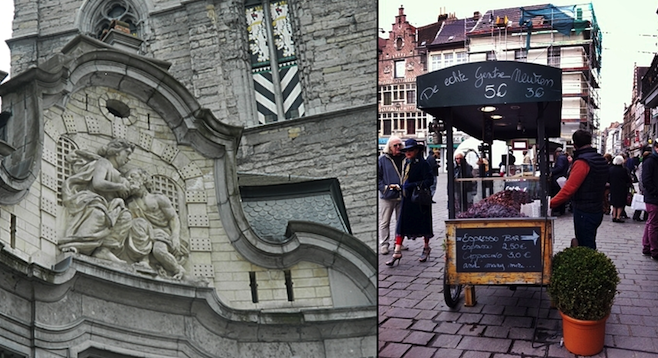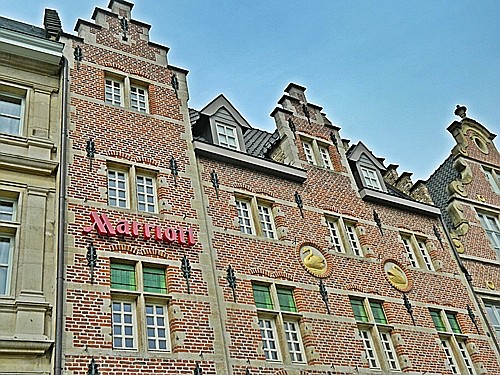 Facebook
Facebook
 X
X
 Instagram
Instagram
 TikTok
TikTok
 Youtube
Youtube

Most of us in the U.S. remember the name “Ghent” from the Treaty of Ghent that finally ended the War of 1812 with the British. At the time, communication was slow, and Gen. Andrew Jackson still brought troops to New Orleans to fight, not knowing a treaty had already been signed. In those days, Ghent was one of Europe’s most populous and powerful cities, and it belonged to the Netherlands. Now it’s a part of Belgium.
Belgians take pride that Ghent is “authentic” – in this case, that means it deviates a bit from the norm or expected. With a university there, it has the vibe that people speak of when they talk about Austin being “weird.”
One thing’s for sure: Ghent seems to have a lot of secrets, both past and present.
Where to stay. There are several hotels in the center part of Ghent, including a youth hostel in an ancient building charging about 30 Euros a night that has a bar on premises and free breakfast.

If hostels aren’t your bag, the Marriott is a cool and convenient place to stay. It’s the first secret I learned about Ghent: the place used to be a brothel for probably hundreds of years! They proudly keep the insignia denoting that fact outside: two swans facing against each other, not mating for life...a Belgian way of saying, “No strings attached.”
At breakfast, they quietly serve an exquisite, locally produced brand of jam, Callas Confiture, that’s even more quietly available for purchase at the front desk.
What to do. In the Count of Flanders’ castle turned local courthouse of the Middle Ages, therein lies another city secret. The basement was a working dungeon – with all the swell things that go along with that. Ghent has turned it into a Museum of Torture, but another “secret” is that it’s not very extensive and 8 Euros to get in.
Instead, for your exposure to deadly thoughts, check out a tiny, friendly bar that used to be the town’s gallows: ‘t Galgenhuisje. It has just a few tables on each level, but they have all kinds of local microbrews on tap and jenevers stocked. Dogs are allowed in, and sometimes they even squeeze some live music in there.
Where is the panel for Mystic Lamb? That question has had a secret answer that not even the police can find out. In Ghent Cathedral, the Van Eyck brothers painted a unique altarpiece for the church in 1432. Through all kinds of wars and turmoil, the masterpiece has survived, except for a panel that went missing in 1934.

What happened to the Mason’s Guild Hall? That was a secret lost to the ages, but then they found it. The building dated from 1526 and it, as well as many other buildings in the area, had new façades added in the 19th century. The city forgot where it was and thought it forever lost! Architects used whatever notes and drawings they had of the old building to recreate where they thought it was – and locate it in time for the 1913 Expo.
It turned out to be a few blocks away and it’s been restored, along with dramatic statues of artisans on top (above). Clearly, it will never be lost again...
Looking for a free (and secret, if you don't look up) sight that's a little on the prurient side? At top of the former entrance to the city prison – now the city’s tourism center – is the Mammelokker statue. It depicts a Roman legend of Cimon, who was condemned to starve to death but saved by his daughter...breast feeding him. Reputedly, the new tourism director is well-endowed and takes the jests in good stride.
What to eat. Right in the center of town is another set of secrets: “neuzen” are these weird, hyper-sweet raspberry jelly candies shaped like noses that ooze thick, purple, snot-like liquid. It’s a Ghent thing.
Two nose carts stand next to each other, each seller claiming to have the better secret recipe. The two guys truly hate each other – apparently, that’s not a secret, as the police have been called in to break up disturbances between them. Both of the noses tasted exactly the same to me. One might've had a slightly more purple color to it.
Just behind the nose sellers is a local mustard boutique, Tierenteyn-Verlent. They make fresh mustard without preservatives according to – you guessed it – a secret recipe. Actually, there are two mustard shops in Ghent with the same name, each founded by brothers who don’t get along and who each claim to have the best secret mustard recipe. With all of the in-fighting in Ghent, it’s kinda surprising we had our treaty signed there!
Here’s an easy-on-the-budget secret for meals, open late for dinner. I didn’t have a chance to stop in, but believe me, I had my eye on it: the local McDonald’s.
Oh sure, the Europeans talk a lot of smack about our American mainstay, but Ghent’s branch location has a purely Belgian sandwich: a McBaguette. It’s made with a fresh baguette, hangar steak, béarnaise and Emmenthaler cheese. Apparently, they also have colorful macarons (different from macaroons) that you see at the poshest society weddings in the U.S. The McD's also has free WiFi, great when your phone is turned to airplane mode.


Most of us in the U.S. remember the name “Ghent” from the Treaty of Ghent that finally ended the War of 1812 with the British. At the time, communication was slow, and Gen. Andrew Jackson still brought troops to New Orleans to fight, not knowing a treaty had already been signed. In those days, Ghent was one of Europe’s most populous and powerful cities, and it belonged to the Netherlands. Now it’s a part of Belgium.
Belgians take pride that Ghent is “authentic” – in this case, that means it deviates a bit from the norm or expected. With a university there, it has the vibe that people speak of when they talk about Austin being “weird.”
One thing’s for sure: Ghent seems to have a lot of secrets, both past and present.
Where to stay. There are several hotels in the center part of Ghent, including a youth hostel in an ancient building charging about 30 Euros a night that has a bar on premises and free breakfast.

If hostels aren’t your bag, the Marriott is a cool and convenient place to stay. It’s the first secret I learned about Ghent: the place used to be a brothel for probably hundreds of years! They proudly keep the insignia denoting that fact outside: two swans facing against each other, not mating for life...a Belgian way of saying, “No strings attached.”
At breakfast, they quietly serve an exquisite, locally produced brand of jam, Callas Confiture, that’s even more quietly available for purchase at the front desk.
What to do. In the Count of Flanders’ castle turned local courthouse of the Middle Ages, therein lies another city secret. The basement was a working dungeon – with all the swell things that go along with that. Ghent has turned it into a Museum of Torture, but another “secret” is that it’s not very extensive and 8 Euros to get in.
Instead, for your exposure to deadly thoughts, check out a tiny, friendly bar that used to be the town’s gallows: ‘t Galgenhuisje. It has just a few tables on each level, but they have all kinds of local microbrews on tap and jenevers stocked. Dogs are allowed in, and sometimes they even squeeze some live music in there.
Where is the panel for Mystic Lamb? That question has had a secret answer that not even the police can find out. In Ghent Cathedral, the Van Eyck brothers painted a unique altarpiece for the church in 1432. Through all kinds of wars and turmoil, the masterpiece has survived, except for a panel that went missing in 1934.

What happened to the Mason’s Guild Hall? That was a secret lost to the ages, but then they found it. The building dated from 1526 and it, as well as many other buildings in the area, had new façades added in the 19th century. The city forgot where it was and thought it forever lost! Architects used whatever notes and drawings they had of the old building to recreate where they thought it was – and locate it in time for the 1913 Expo.
It turned out to be a few blocks away and it’s been restored, along with dramatic statues of artisans on top (above). Clearly, it will never be lost again...
Looking for a free (and secret, if you don't look up) sight that's a little on the prurient side? At top of the former entrance to the city prison – now the city’s tourism center – is the Mammelokker statue. It depicts a Roman legend of Cimon, who was condemned to starve to death but saved by his daughter...breast feeding him. Reputedly, the new tourism director is well-endowed and takes the jests in good stride.
What to eat. Right in the center of town is another set of secrets: “neuzen” are these weird, hyper-sweet raspberry jelly candies shaped like noses that ooze thick, purple, snot-like liquid. It’s a Ghent thing.
Two nose carts stand next to each other, each seller claiming to have the better secret recipe. The two guys truly hate each other – apparently, that’s not a secret, as the police have been called in to break up disturbances between them. Both of the noses tasted exactly the same to me. One might've had a slightly more purple color to it.
Just behind the nose sellers is a local mustard boutique, Tierenteyn-Verlent. They make fresh mustard without preservatives according to – you guessed it – a secret recipe. Actually, there are two mustard shops in Ghent with the same name, each founded by brothers who don’t get along and who each claim to have the best secret mustard recipe. With all of the in-fighting in Ghent, it’s kinda surprising we had our treaty signed there!
Here’s an easy-on-the-budget secret for meals, open late for dinner. I didn’t have a chance to stop in, but believe me, I had my eye on it: the local McDonald’s.
Oh sure, the Europeans talk a lot of smack about our American mainstay, but Ghent’s branch location has a purely Belgian sandwich: a McBaguette. It’s made with a fresh baguette, hangar steak, béarnaise and Emmenthaler cheese. Apparently, they also have colorful macarons (different from macaroons) that you see at the poshest society weddings in the U.S. The McD's also has free WiFi, great when your phone is turned to airplane mode.
Comments